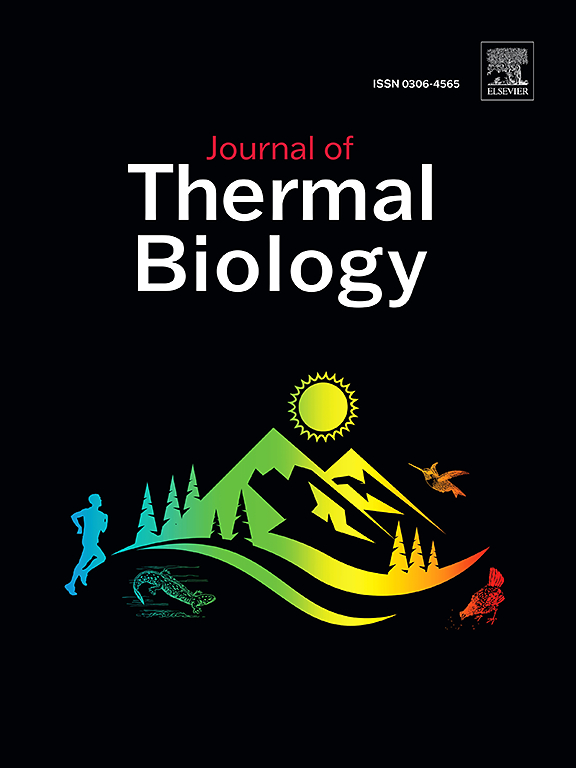溪鳟失去长期热适应能力的速度有多快?
IF 2.9
2区 生物学
Q2 BIOLOGY
引用次数: 0
摘要
适应冷水的溪流鱼类种群的丰度正在下降,主要是由于人为影响,包括温度升高。为了在不适合热生境的溪流中生存,鱼类必须迁移到冷水区,适应或适应高于热最佳温度的水温。布鲁克鳟鱼是一种适应冷水的鲑鱼,以前在较高的温度下饲养时显示出生理可塑性和可逆热适应能力。然而,由于水流温度不是静态的,探索热适应发生的速率以评估先前的热经验是否会影响未来的热性能是很重要的。为了确定水温降低时热适应损失的时间尺度,我们将鳟鱼驯化到三种热环境:+0°C(环境温度;模拟附近长期研究地点的日平均水温),以及高于环境温度+2°C和+4°C。在这些条件下饲养2年后,从温暖的处理中取出的鱼被转移到一个普通的,更冷的温度(环境)。然后,我们使用临界热最大值来测量每种处理对鱼的驯化反应随时间的损失。我们发现,无论初始驯化温度如何,热驯化鱼的热耐受性在1周内迅速下降,然后逐渐下降,并在42 d内完全丧失。这种逐渐丧失的适应环境可能对在较温暖的溪流中生存很有价值,而且将其纳入气候变化对溪鳟和其他具有显著热可塑性的水生变温动物的影响模型也很重要。本文章由计算机程序翻译,如有差异,请以英文原文为准。
How quickly do brook trout lose long-term thermal acclimation?
Abundances of coldwater adapted stream fish populations are declining largely due to anthropogenic influences, including increased temperature. To persist in streams with unsuitable thermal habitat, fish must move to coldwater patches, acclimate, or adapt to water temperatures above thermal optima. Brook trout, a coldwater adapted salmonid, has previously displayed physiological plasticity and the ability for reversible thermal acclimation when reared at higher temperatures. However, because stream temperatures are not static, it is important to explore the rate at which thermal acclimation occurs to evaluate whether prior thermal experience will influence future thermal performance. To determine the temporal scale in loss of thermal acclimation as water temperatures cool, we acclimated brook trout to three thermal regimes: +0 °C (ambient; mimicking the daily average water temperature of a nearby long-term study site), as well as +2 °C and +4 °C above ambient. After 2 years of being reared under those conditions, fish from the warmer treatments were moved to a common, colder temperature (ambient). We then used critical thermal maximum to measure the loss in acclimation response of fish from each treatment over time. We found that regardless of initial acclimation temperature, thermal tolerance of warm acclimated fish decreased rapidly for 1 week, then gradually decreased, and was completely lost within 42 days. This gradual loss of acclimation may be valuable to persistence in warmer streams and will be important to include in models of the impact climate change has on brook trout and other aquatic ectotherms with significant thermal plasticity.
求助全文
通过发布文献求助,成功后即可免费获取论文全文。
去求助
来源期刊

Journal of thermal biology
生物-动物学
CiteScore
5.30
自引率
7.40%
发文量
196
审稿时长
14.5 weeks
期刊介绍:
The Journal of Thermal Biology publishes articles that advance our knowledge on the ways and mechanisms through which temperature affects man and animals. This includes studies of their responses to these effects and on the ecological consequences. Directly relevant to this theme are:
• The mechanisms of thermal limitation, heat and cold injury, and the resistance of organisms to extremes of temperature
• The mechanisms involved in acclimation, acclimatization and evolutionary adaptation to temperature
• Mechanisms underlying the patterns of hibernation, torpor, dormancy, aestivation and diapause
• Effects of temperature on reproduction and development, growth, ageing and life-span
• Studies on modelling heat transfer between organisms and their environment
• The contributions of temperature to effects of climate change on animal species and man
• Studies of conservation biology and physiology related to temperature
• Behavioural and physiological regulation of body temperature including its pathophysiology and fever
• Medical applications of hypo- and hyperthermia
Article types:
• Original articles
• Review articles
 求助内容:
求助内容: 应助结果提醒方式:
应助结果提醒方式:


